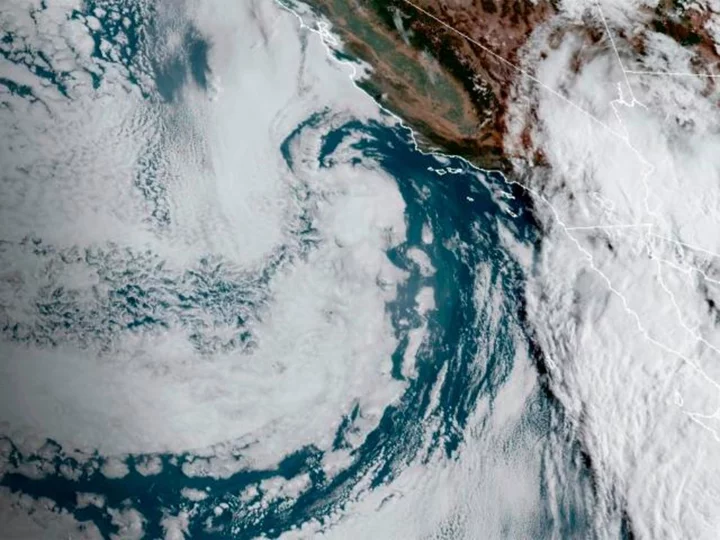Hurricane Hilary is expected to slam into Southern California on Sunday as a rare tropical storm, unleashing floods, fierce winds and heavy downpours as residents evacuate, parks and beaches close and first responders brace for water rescues.
Hilary is now a Category 1 storm churning maximum winds of 85 miles per hour as it barrels north-northwest at a speed of 20 mph, according to the National Hurricane Center. It was about 450 miles south from San Diego as of 11 p.m. local time Saturday.
Live updates: Hurricane Hilary to bring major flooding risk to California
The hurricane is expected to weaken to a tropical storm before it reaches the US -- but it'll still likely pack a powerful punch in the Southwest, with "catastrophic and life-threatening" flooding expected, according to the hurricane center.
The storm is forecast to dump 3 to 6 inches of rain -- or even 10 inches in some areas -- and whip up damaging winds that can knock power out for many. The worst of it is expected Sunday into Monday.
California Gov. Gavin Newsom proclaimed a state of emergency Saturday for a large swath of Southern California to support hurricane response and recovery efforts, according to the governor's office.
"We're mobilizing all of government as we prepare and respond to this unprecedented storm," Newsom said.
A hurricane warning is in effect in Mexico from Punta Abreojos to Cabo San Quintin -- a roughly 300-mile stretch along the Baja California Peninsula's western shore.
"Flash and urban flooding, locally catastrophic, is expected, especially in the northern portions of the peninsula," the National Hurricane Center said Saturday night, with rainfall totals of 3 to 6 inches possible.
Although Hilary is forecast to move north from Baja California into Southern California Sunday afternoon, its impacts will be felt earlier.
"Preparations for flooding impacts associated with Hilary should be completed as soon as possible, as heavy rainfall will begin well in advance of the center," the hurricane center said.
Parts of California, Nevada and Arizona that are unaccustomed to rain could suddenly receive a year's worth or more. And along the coast, large swells generated by Hilary are likely to create life-threatening surf and rip current conditions.
The threat has triggered California's first ever tropical storm warning extending from the state's southern border to just north of Los Angeles. Hilary is also forecast to be "the wettest tropical cyclone in state history," according to the California governor's office.
Hilary "could be one of the most devastating storms that we've had hit California in more than a decade," said Nancy Ward, director of the California Governor's Office of Emergency Services.
If Hilary makes landfall in California as a tropical storm, it would be the first such storm to do so in the state in nearly 84 years, according to data from the National Oceanic and Atmospheric Administration.
Residents of the San Bernardino County communities of Oak Glen, Forest Falls, Mountain Home Village, Angelus Oaks, and Northeast Yucaipa were all ordered to evacuate Saturday.
Visitors and some residents of Catalina Island, part of California's Channel Islands, were "strongly encouraged" to leave the island ahead of the storm in a news release from the City of Avalon.
Meanwhile, helicopters from the Los Angeles County Sheriff's Office were flying over riverbed areas Saturday afternoon, making announcements in both English and Spanish to warn homeless people about the extreme weather.
On top of the threats of heavy rainfall and swollen surf, Hilary also brings with it the threat of isolated tornadoes Sunday from mid-morning through the evening over parts of the lower Colorado River Valley, Mojave Desert and Imperial Valley regions, according to the hurricane center.
Concern for deserts and recent burn areas
As Hilary approaches, California is particularly focused on preparing residents in areas that typically receive the least rain, or that were most recently scorched by wildfires, authorities said.
"We're keeping a very close eye on our desert regions, east of San Diego and Los Angeles. Some parts of these areas may receive double their yearly amount of water in just a single day," said Brian Ferguson, the deputy director of the California Governor's Office of Emergency Services.
Lingering burn scars from wildfires can create a steep, slick surface for water and debris to flow off. People who live downhill and downstream from burned areas are very susceptible to flash flooding and debris flows.
"Rainfall that would normally be absorbed will run off extremely quickly after a wildfire, as burned soil can be as water repellant as pavement," the National Weather Service said.
In Orange County, a voluntary evacuation warning was issued for Silverado Canyon and Williams Canyon in the Bond Fire burn area due to possible debris flows along or near the burn scar.
Residents have been offered sandbags to fortify their property in counties across Southern California, where some of the natural buffers against flooding have been burned away.
First responders have also pre-positioned to respond quickly and perform water rescues from flooded areas, state officials said.
There are "more than 7,500 boots on the ground" already deployed to help protect from the impact of Hurricane Hilary, according to the release from Newsom's office.
Meanwhile, the state is also preparing for power outages.
"There will be power outages across Southern California," Ward said. "And we want to be sure we have this close communication with those utility companies to ensure that they can restore power as quickly as they possibly can."
Electricity utility Southern California Edison -- which serves more than 15 million people in the region -- said Thursday Hilary is on track to impact much of its service area. The company said it is preparing to respond to outages but urged residents to gather supplies including flashlights, external battery chargers and ice chests.
The approaching storm has already led to disruptions across California: All state beaches in Orange and San Diego counties were closed; the US Navy is temporarily relocating San Diego-based ships and submarines; Los Angeles County closed parks, beaches, playgrounds, restrooms and trails; Major League Baseball overhauled its weekend schedule; and Sunday's My Morning Jacket and Fleet Foxes concert at the Hollywood Bowl has been postponed.









